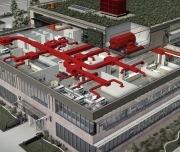System Impacts
Resources Impact
The HVAC system has a tremendous impact on natural resources, through electricity, gas, and other purchased energy as well as water consumption, materials, and refrigerants. Take steps to optimize the system’s efficiency, implement water conservation measures, and reduce environmental impacts.
Systems Optimization
There is a good chance your building systems are not operating at their peak efficiency. The reasons for this are many, including but not limited to:
- Changes in the use of the building
- Different climate conditions than when the building was designed
- "Temporary" control overrides that were never reset back to normal
- Piecemeal replacement of equipment due to breakdowns over the years
Ensure your systems are in proper working order and working well together through commissioning. Learn more about commissioning, retrocommissioning, and recommissioning in the O&M Section.
Energy Use
Conservation Measures
Environmental Impact
Best Practices and Strategies
| When selecting new equipment, examine the entire lifecycle cost by comparing first costs, operating costs (energy savings, for example), and disposal costs. | Get the most out of your building systems. Learn more about commissioning in the O&M Section. |

